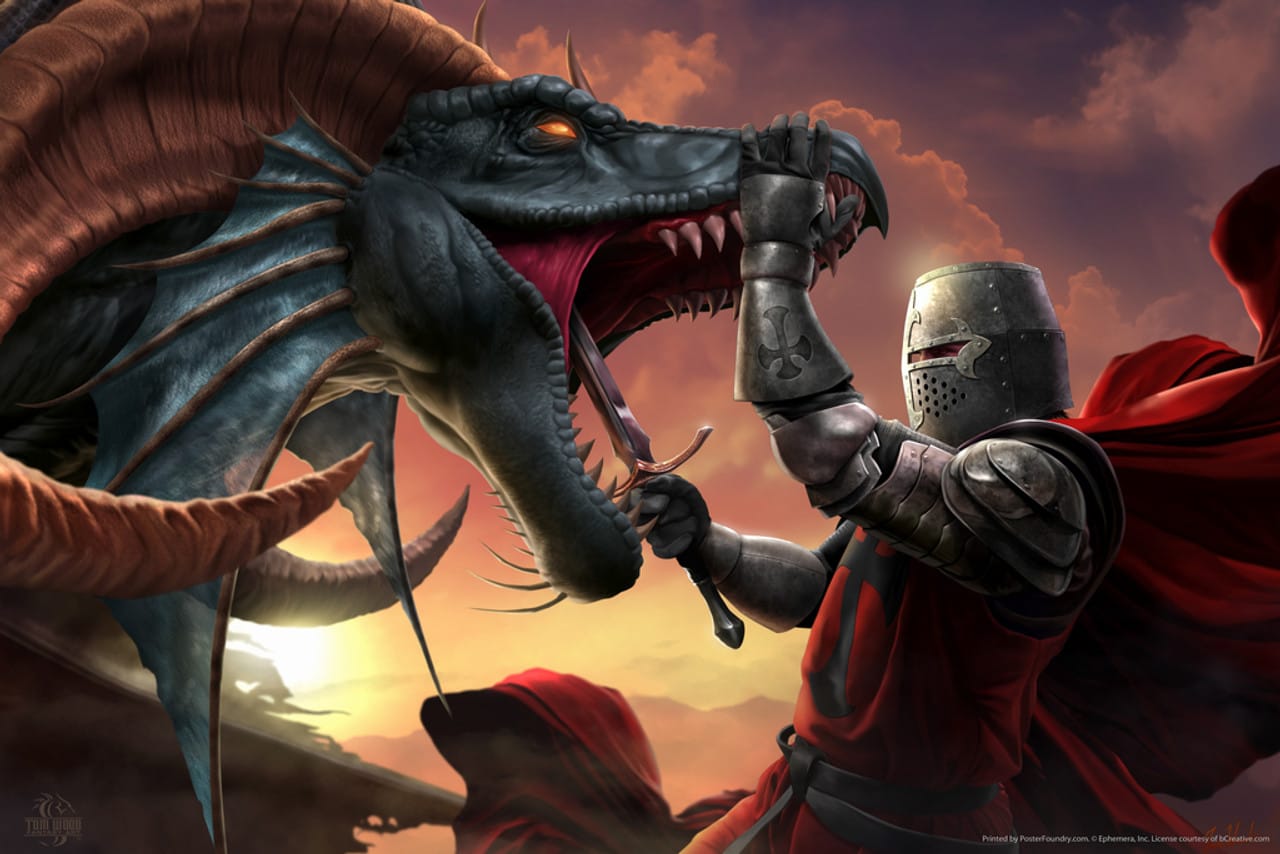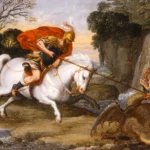Get ready for an adventure that’s both epic and fascinating! We’re going to dive into the legend of Saint George, the super-brave knight who took down a monstrous dragon. This story has been keeping people on the edge of their seats for centuries, and it’s not just because it’s one of the coolest battles ever. There’s a deeper meaning here, a message about the power of good over evil. Let’s explore how this legend has shaped us, from the ancient stories in medieval books to the blockbuster movies we watch today. We’ll also uncover other dragon-slaying heroes and learn what this legend tells us about ourselves and the world around us.
Knight Killing a Dragon
We’ve all seen it, haven’t we? That classic image of a brave knight, facing down a terrifying dragon, the beast’s fiery breath scorching the earth around them. It’s a story as old as time, retold through generations in books, songs, and even on the big screen. But what is it about this particular tale that keeps us captivated?
Well, for starters, it’s about way more than just a guy in shining armor with a pointy stick. The knight killing a dragon is a powerful symbol, one that speaks to something deep within the human spirit. It’s the ultimate showdown between good and evil, courage versus fear, right against might.
Think about it. In the stories, the knight isn’t just fighting a big lizard with wings. The dragon represents everything dangerous and chaotic, a threat to the kingdom and its people. It breathes fire, hoards treasure, and embodies the darkest fears of those who hear its roar.
One of the most famous examples? The legend of Saint George, the dragon-slaying knight, embodies this symbolism. In his story, the dragon wasn’t just a scary monster; it symbolized the old pagan beliefs that were seen as a threat to the new Christian faith. When George defeated the dragon, it was like a victory for Christianity itself! This story has echoed through history, inspiring countless paintings, poems, and plays over the centuries.
But the knight versus dragon fight is more than just a religious allegory. Knights were often tasked with killing dragons as they represented both a physical threat and a symbol of demonic authority. This reflects the real-life struggles of medieval times when knights were often called upon to defend their lands against all sorts of dangers, from invading armies to dangerous bandits. The dragon became a powerful symbol for any enemy that threatened the peace and order of society.
And of course, we can’t forget the personal journey of the knight. Facing down a dragon wasn’t just about physical strength; it took incredible courage and determination. The knight had to overcome his own fear and doubt to defeat such a terrifying opponent. In many ways, the dragon represented the greatest challenge a knight could face, and slaying it marked a triumphant moment of personal growth and victory.
The Legend of Saint George and the Dragon: A Tale of Courage and Faith
The did st george kill a dragon is a timeless tale that has been told for centuries. The story of St. George, a brave knight who slays a fearsome dragon, is one that has captured the imaginations of people of all ages. Picture this: a ferocious dragon, terrorizing a whole town, holding them hostage for their precious water. But then, in rides our hero, Saint George, a shining beacon of courage and faith. George isn’t some muscle-bound giant; he’s a man of deep belief, and he knows in his heart he has to face this beast.
The battle is epic; George, armed with his faith and sword, against the fire-breathing dragon. It’s a clash of good versus evil, a fight for the town’s very survival. And guess what? George, through sheer willpower and trust in his beliefs, slays the dragon, freeing the town from its fear.
But this legend isn’t just about a knight and a monster. It’s a powerful metaphor, a reminder that we all face our own dragons, those challenges and fears that loom large in our lives. George’s victory? It’s a symbol of what we can achieve when we dig deep, find that inner strength, and believe we can overcome anything. In the story of Saint George, the dragon represents the pagan beliefs and practices that threatened early Christian communities.
George became a legend, a symbol of bravery and unwavering faith. He’s like the ultimate knight, the patron saint of chivalry, inspiring countless others to be brave, to fight for what’s right, and to never back down from a challenge. His story, passed down through centuries, continues to resonate with people all over the world. It reminds us that even in the darkest of times, hope and courage can prevail. It’s a story that transcends cultures and religions, a timeless message of good conquering evil, inspiring us all to face our own dragons with courage and faith.
Why Do Knights Fight Dragons? Exploring the Symbolism
We’ve all heard the stories, seen the paintings, maybe even dreamed of the epic clashes ourselves: brave knights taking on terrifying dragons. But it’s not just about a good fight, is it? There’s something deeper going on, a story told in symbols and metaphors that has resonated through the ages.
Think about it. Knights, these warriors bound by oaths and honor, dedicated to protecting the helpless. And dragons, massive, fire-breathing creatures of destruction, the ultimate threat to a peaceful kingdom. These clashes weren’t just about brute force, they were about something much bigger.
Imagine a village living in fear, whispers of a dragon’s shadow falling across their fields, the very air smelling of smoke and danger. Then, a knight arrives, shining armor glinting in the sun, a symbol of hope against the darkness. Defeating the dragon wasn’t just about killing a monster, it was about proving that courage and goodness could prevail, even against overwhelming odds. It was a victory for everyone the dragon threatened, a reassurance that someone was out there fighting for them. Knights fought dragons to protect the innocent. Dragon-slaying symbolized the triumph of good over evil.
And let’s not forget what it meant for the knights themselves. Chivalry wasn’t just about fancy feasts and wooing fair maidens. It was a demanding code that pushed these warriors to test their limits, to face down their fears and emerge victorious. What better way to prove your mettle than to stand against a fire-breathing dragon? Chivalry demanded knights confront and defeat dragons. A knight who could conquer such a beast wasn’t just strong, he was practically a legend, his name etched in the annals of heroism.
But there’s another layer to these stories, one that speaks to something within us all. Think of the dragon as a metaphor, a symbol for the challenges and fears we face in our own lives. That fearsome beast could represent anything from self-doubt to impossible odds, and the knight’s struggle becomes our own. Dragons in literature represented challenges and obstacles.
So when you see that image of a knight facing down a dragon, remember, it’s about more than just a fight. It’s about courage in the face of fear, the power of good to triumph over evil, and the enduring human spirit that finds ways to overcome even the most daunting challenges.
From Medieval Manuscripts to Modern Cinema: The Enduring Appeal of Dragon Slaying
We’ve already talked about how dragon-slaying stories show up everywhere, but let’s dive deeper into why these tales never seem to get old. What is it about knights and fire-breathers that keeps us coming back for more? Dragon slaying has captivated imaginations since medieval times.
Knights, Manuscripts, and Mayhem: Dragons in the Middle Ages
Imagine cracking open a dusty old book from the Middle Ages and BAM— there’s a dragon staring back at you. These weren’t your friendly neighborhood lizards, either. Medieval artists went all out, painting dragons with intricate details, often showcasing them as symbols of evil or the big baddie a hero had to overcome. Think of them like the final boss level in a video game. Medieval manuscripts depict dragons in art and symbolize evil or challenges for heroes.
And speaking of stories, medieval literature was packed with dragon-slaying action. You’ve got Beowulf, a legendary warrior facing off against a treasure-hoarding dragon. Then there’s the Nibelungenlied, another epic filled with courageous knights and, you guessed it, more epic dragon battles. These tales weren’t just about slaying monsters; they were about bravery, chivalry, and the struggle between good and evil—themes that still resonate with us today.
From Page to Screen: Dragons in Modern Movies
Fast forward a few centuries, and dragons aren’t just confined to ancient books anymore—they’re lighting up the big screen! Modern cinema utilizes dragons in fantasy and horror genres. Think about movies like “The Hobbit” and “Game of Thrones.” These films give us majestic dragons with incredible powers, almost like forces of nature you can’t help but respect (even if they could roast you with a single breath).
But dragons aren’t always portrayed as noble creatures. Horror movies like “Dragonheart” and “Reign of Fire” remind us that these beasts can be downright terrifying, bringing destruction and chaos wherever they go. It’s this duality – the potential for both awe and terror – that keeps dragons fascinating even in the age of CGI.
More Than Just Monsters: The Symbolism of Dragons
Dragons aren’t just cool-looking creatures—they’re loaded with symbolism. In medieval times, they often represented the forces working against faith and goodness. They were the ultimate test for heroes and a visual reminder of the ever-present battle against evil. Medieval art sees dragons as threats to Christianity, while modern works connect them to environmental and political issues.
But their meaning doesn’t stop there. In modern stories, dragons can represent anything from environmental destruction to political oppression—even our own internal struggles. Dragons symbolize chaos, power, and personal struggles. They embody the challenges we face and the courage it takes to overcome them. Think about it: facing a dragon takes guts, whether it’s a literal fire-breathing beast or a metaphorical obstacle in your path. Dragon slaying represents the human struggle against evil, courage, and personal growth.
- Unlock Elemental 2 Secrets: Actionable Insights Now - April 2, 2025
- Lot’s Wife’s Name: Unveiling the Mystery of Sodom’s Fall - April 2, 2025
- Photocell Sensors: A Complete Guide for Selection and Implementation - April 2, 2025

















Comments are closed.